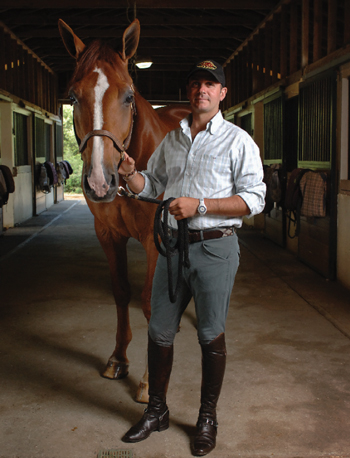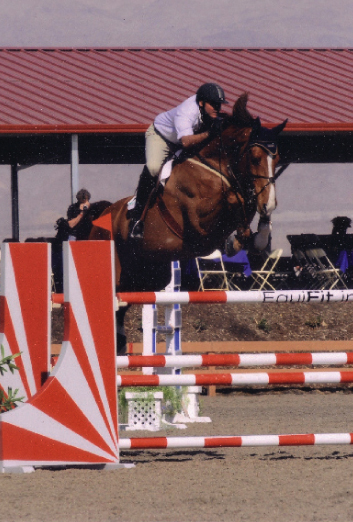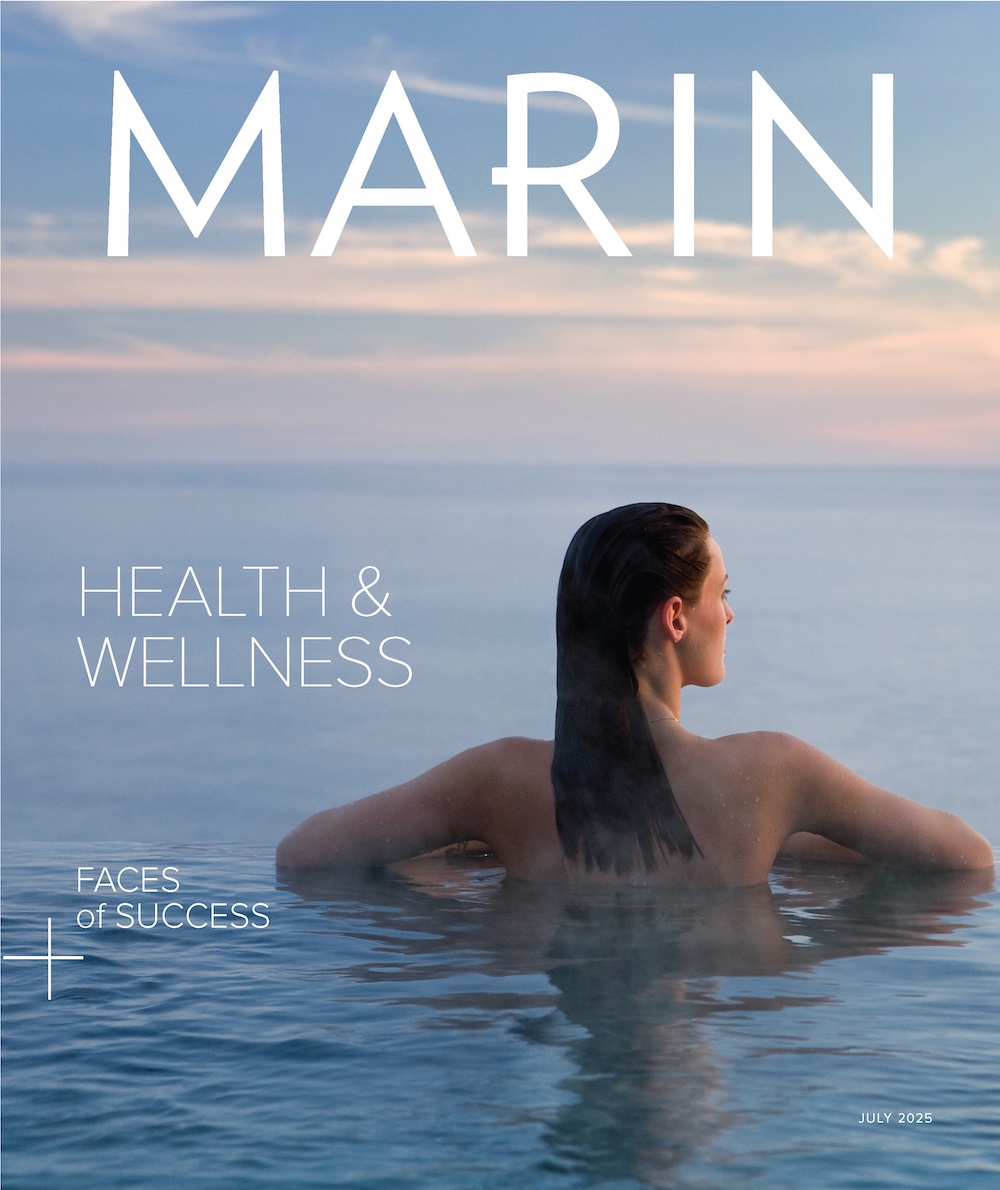On an early summer morning at Edgewood, a 60-acre farm on Nicasio Valley Road devoted to training and breeding performance horses, a slim, handsome rider lifts himself onto an equally handsome mount.They move together with ease. Mariano Alario’s body is relaxed, his tanned arms lightly holding the bridle’s reins. Cinnamon 005’s neck is elegantly arched and held high as he steps carefully, mincingly almost, into the sandy exercise arena.
Moments before, Alario, neatly but casually dressed, had briskly brushed his dark riding boots on a patio outside the low-slung putty-colored barn and donned a pair of black gloves.
Inside, Cinnamon stood patiently, being groomed. A pair of young dogs wrestled in the breezeway and the pulsing beat of norteño music, a favorite of the Mexican stable hands, wafted in from a dusty boom box.
Like the seductive tango dancers of Alario’s native Argentina, the professional show jumper and his equine partner primp and prepare for their own interspecies version of intense synchronized dance. Today, the workout is easy: an escalation from walk to trot to canter performed in small loops and larger circles within the arena.
A bystander unfamiliar with the equestrian world might mistake it for a mindless exercise instead of the active effort of concentration that Cinnamon’s owner and Alario’s employer, Nancy Hersh, knows is crucial to their progress as a team. “There has to be a chemistry between them,” Hersh says of the two newcomers to the valley and to each other. “They really have to develop a relationship.”
Top-level equestrian jumping is an exhilarating sport wherein composed fearlessness, controlled speed, supreme athleticism and impossible grace meet in midair when man and horse, communicating swiftly and silently, soar as one. That unity only comes with time together.
Hersh, a crisp-spoken San Francisco personal-injury attorney, has developed her own chemistry with horses. She began riding as a child on a neighbor’s horses. Three years ago, Hersh bought Edgewood with her husband, Joe Boyle, her law-firm partner Mark Burton, and his wife, Robyn, and hence can now fully indulge her passion for horses, the ones she rides western-style for pleasure or a special one, like Cinnamon, that Alario rides.
 Alario dismisses any romantic notion of chemistry, even when it comes to Cinnamon, a tall (7 feet, hoof to head) German-born Holsteiner that he hopes will take him to the prestigious World Cup in Stockholm this year and the summer Olympics in Beijing next year.
Alario dismisses any romantic notion of chemistry, even when it comes to Cinnamon, a tall (7 feet, hoof to head) German-born Holsteiner that he hopes will take him to the prestigious World Cup in Stockholm this year and the summer Olympics in Beijing next year.
“No, it’s not chemistry; you just have to understand each other,” he says, his English softened with the rolling vowels of his home country. “You see that mare over there?” He gestures to a dark bay being ridden by Edgewood’s veteran trainer, Bob Walker. “Bob’s trying to figure out why she’s resisting him. You have to know what the horse is thinking and then think [for instance], ‘Maybe if I use my right leg more, it would be better.’”
A rider’s relationship with a horse, he adds, is built on trust and respect. “Cinnamon’s 10 years old,” he says, shrugging. “At this point, I can’t change his technique, but I can make him nice and soft before we start a course. We have to work on the control. You cannot be the strongest man in the world, right? The horses are stronger than you so you have to have control.”
This insight comes from a lifetime of riding. His father, Oscar Alario, a lawyer who ran an insurance company in the seaside resort town of Mar del Plata, far from Argentina’s equitation center of Buenos Aires, would leave work every afternoon for the Club Hipico Mar Del Plata to teach show jumping to Mariano and other students.
“We’re crazy people for horses,” says Alario, now 29, breaking into a boyish smile as he tells of his father’s obsession for everything gaucho—the iconic cowboy of Argentina. “It’s always been 100 percent horses for me. I’ve never done another sport.”
Image 2: Horse and rider get ready to start the day.
At 15, Alario was jumping in Grand Prix classes, the highest level in the competitive riding world, and had taken over teaching his father’s roster of students. He graduated from college, but gave up law school after a year to focus on his show-jumping career. In 1999, he moved to Spain, jumping there for two years ago before coming to the United States. Two years ago, he represented Argentina in the World Cup, something he’s determined to do again this time on Cinnamon.
That would be a dream realized for Hersh. “We were so lucky to find Cinnamon,” she says. “We were looking for a horse for Mariano when we got a call that Cinnamon was for sale and if we didn’t act right away, he was going to Europe. Bob and Mariano hopped on the next plane (to Virginia) and that was it.”
That was last November. Hersh won’t say how much she paid for Cinnamon, but does say she’s been offered three times that purchase price. Horses of this caliber can easily cost a million dollars or more. It’s an expensive sport, and because he’s a gelding, Cinnamon can’t recoup his costs through stud fees. He needs to pay his way with prize money won on the show circuit.
 Physically, Cinnamon has what it takes—a deep chest, strong, rounded knees, a well-developed back, muscular hindquarters and legs. Three years younger than most other horses at his level, he’s already been a top East Coast and European competitor. “There’s not another horse in Marin who can do the Grand Prix–Olympic-level jumping that he can,” Hersh says, “and there’s only a handful that can do it on the West Coast.”
Physically, Cinnamon has what it takes—a deep chest, strong, rounded knees, a well-developed back, muscular hindquarters and legs. Three years younger than most other horses at his level, he’s already been a top East Coast and European competitor. “There’s not another horse in Marin who can do the Grand Prix–Olympic-level jumping that he can,” Hersh says, “and there’s only a handful that can do it on the West Coast.”
Cinnamon is just one of 35 horses at Edgewood, but he “knows he’s special,” says Hersh. “He’s the king and he gets preferential treatment.” That includes custom-fitted tack, first dibs on the best pasture and daily pampering.
If Cinnamon is spoiled, however, he doesn’t show it. Under Alario’s guidance, he works with a gentle earnestness. “He’s a super athlete with a big heart,” says Walker. “He’s got to have that because he’s got to be brave. He also has to have scope and the elasticity in his body to handle wide jumps and do them one right after the other.”
Alario and Cinnamon are not Olympic shoo-ins, even in Argentina, where there is less competition for the equestrian team than in the United States. Alario’s fiancée, Nina Herrera, a head trainer at Edgewood, says her husband-to-be is “under a lot of pressure to perform well here and to show Argentina what he’s got.”
Serious training begins next month when Alario and Cinnamon travel to Southern California for the first six World Cup qualifiers. They’ll then fly to Argentina—Alario by commercial airline and Cinnamon by Federal Express—for more competition, and next to Southern California for the final six qualifiers in February and March. In April, the World Cup trials are held in Stockholm.
“If he does well there, it’s a huge plus for his chances in getting on the Olympic team,” Herrera says. “If you have success at the World Cup against competitors from major countries, you’re among the best. There are probably only 100 riders who are even capable of attempting it.”
In Grand Prix show jumping, rider and horse must clear at least 15 different types of hurdles: singles, combinations, and water jumps—some as high as five feet and as wide as six. They have less than two minutes to complete the circuit. Mistakes bring penalties. “You don’t have time to think between the jumps,” Alario says. “You only have time to regroup your horse and think about jumping the next jump perfectly.”
Alario will know by June if they qualify for the Olympics. If they do, Alario and Cinnamon will meet their toughest competitors—Europeans who routinely ride on courses more challenging than those in the United States—and jump on five demanding courses over three days.
In the meantime, Cinnamon has to stay healthy. “Keeping horses sound on the road and asking them to do something that’s not natural—jumping big jumps with their big bodies on skinny legs and little feet—is a lot of wear and tear on them,” says Walker.
To minimize injury, Cinnamon cross-trains—a mixture of flat/ground work, trail-riding, gymnastics and low-jumping. “We don’t overdo it,” says Walker. “Those big efforts are hard on the horses and the more you push them, the more the chances of breaking them.”
For Walker, the goal is developing a Grand Prix horse. “The Olympics would just be icing on the cake.”
Image 3: Mariano Alario and Cinnamon go through their paces in preparation for jumping competition.


